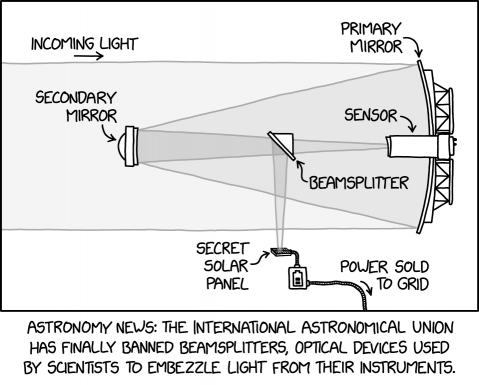2991: Beamsplitters
| Beamsplitters |
 Title text: Under quantum tax law, photons sent through a beamsplitter don't actually choose which path they took, or incur a tax burden, until their wavefunction collapses when the power is sold. |
Explanation
| This is one of 60 incomplete explanations: Created by a SOLAR PANEL HIDDEN DEEP IN MEDIAWIKI'S HQ - Please change this comment when editing this page. Do NOT delete this tag too soon. If you can fix this issue, edit the page! |
A beamsplitter is a device, usually made from a pair of prisms or a half-silvered mirror, that splits a beam of light into two beams going in different directions. In the diagram in the comic, a beamsplitter has been inserted into the path of light in a reflecting telescope so that some of the light going to the detector is redirected to a solar panel. The electricity generated there is then sold to a power grid supplier.
Transcript
| This is one of 33 incomplete transcripts: Do NOT delete this tag too soon. If you can fix this issue, edit the page! |
Discussion
Pictures taken by telescope are filtered one colour at the time. If the filtered out colours could be diverted, those photons could be harvested without interfering with the scientific studies. Of course, it would still not be economically efficient. 162.158.127.100 00:33, 28 September 2024 (UTC)
- Yes, a classic beam-splitter was the first color TV cameras. Three camera tubes (probably vidicons?) on the three outputs of two filtering beamsplitters. Later they did it all in one bottle; still later three chips on two beamsplitters. Color TV can be whacky. --PRR (talk) 01:35, 28 September 2024 (UTC)
The wavefunction explanation at the time the electron is generated is "wrong". The photovoltaic cell and the electron get entangled. See Wigner's Friend watching Schrödinger's Cat. Sebastian --172.68.110.188 16:19, 30 September 2024 (UTC)
- Please edit accordingly, with my thanks! 172.68.22.8 16:31, 30 September 2024 (UTC)
[[1]] 172.68.225.192 (talk) 01:00, 19 November 2024 (please sign your comments with ~~~~) <-- this link seems to be a legit comment on Beamsplitters, but the person who dropped it here really doesn't do themselves too many favours...
A difference of 5 magnitudes corresponds to a factor of 100 in brightness. The sun has magnitude -27, and Vega (by definition) is magnitude 0. This means that at Earth, the sun is 6e10 times brighter than Vega. Therefore a 10m diameter telescope (78.5 m^2) collects as much energy from Vega as a solar panel of size 1.23e-9 m^2, or a square 35 microns on a side. The brightest star, Sirius, is magnitude -1.46, which makes our 10m telescope equivalent to a square solar panel 70 microns on a side. (This calculation is a bit rough. To do it properly, we'd need to know the wavelength band which the solar panel can transform into electricity, and the magnitudes of the sun and star at that specific wavelength band.) 198.41.236.144 03:08, 2 October 2024 (UTC)
- Suppose that telescope was aimed towards Vega on a sunny day with a clear sky, with a path that didn't intersect the sun. How much brighter is the sky itself, from scattered sunlight, than Vega? There are a lot of factors that would make a great deal of difference, but suppose we assume that the sun is directly overhead. BunsenH (talk) 19:42, 2 October 2024 (UTC)
- At first approximation, similar to a panel of the size of the aperture. Although the difference between the power landing on an 'end cap' panel and reaching down into a reciever down the length of the 'telescope tube' would be that the panel receives light from 2π steradians of sky (albeit only at top efficiency towards the perpendicular), whilst the better analogue might be a panel, the size of the barrel and down the barrel, set back where the primary mirror is so as to receiver (effectively, more or less) collimated light from the top end. Probably equal to a slightly overcast whole-sky (assuming it's a panel with good blue-absorption qualities and decent cross-spectrum sensitivity, rather than heavily reliant upon solar energy bands).
- The next question is whether the concentration of this viewport of the sky benefits from being concentrated via the lensing, but I suspect not. If anything, the localised heating might lower the efficiency, etc. 172.69.195.103 21:42, 2 October 2024 (UTC)
 Add comment
Add comment
